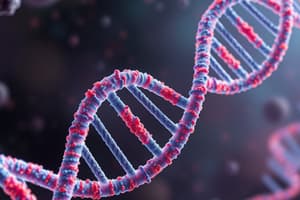Podcast
Questions and Answers
What is the function of the DnaA protein in DNA replication in prokaryotes?
What is the function of the DnaA protein in DNA replication in prokaryotes?
- It breaks the hydrogen bonds between base pairs to initiate replication
- It creates the Y-shaped replication fork structure
- It binds to the G/C-rich sequences in the ori site
- It binds to the A/T-rich sequences in the ori site and stretches the double-stranded DNA (correct)
Why is the ori site in prokaryotes mostly comprised of A/T-rich sequences?
Why is the ori site in prokaryotes mostly comprised of A/T-rich sequences?
- A/T-rich sequences are stronger and more stable than G/C-rich sequences
- A/T-rich sequences are more compatible with the DnaA protein
- G/C-rich sequences are not present in prokaryotic DNA
- A/T-rich sequences are easier to break than G/C-rich sequences (correct)
How many replication forks are created during DNA replication in prokaryotes?
How many replication forks are created during DNA replication in prokaryotes?
- Two (correct)
- Four
- One
- Three
Why is the ori site in prokaryotes mostly composed of A/T-rich sequences?
Why is the ori site in prokaryotes mostly composed of A/T-rich sequences?
How many replication forks are created during DNA replication in prokaryotes?
How many replication forks are created during DNA replication in prokaryotes?
Flashcards are hidden until you start studying
Study Notes
DNA Replication in Prokaryotes
- DnaA protein binds to the origin of replication (ori) and unwinds the double helix, facilitating the recruitment of other proteins necessary for DNA replication.
- The ori site in prokaryotes is mostly comprised of A/T-rich sequences because they are more easily melted, allowing for the initiation of DNA replication.
- During DNA replication in prokaryotes, two replication forks are created, one moving clockwise and the other counterclockwise, allowing for bidirectional replication.
Studying That Suits You
Use AI to generate personalized quizzes and flashcards to suit your learning preferences.




